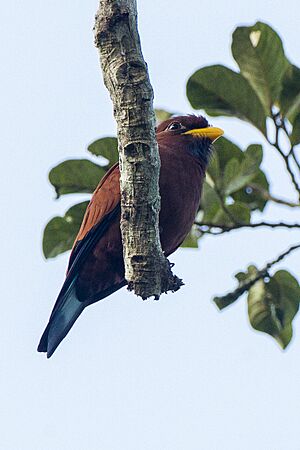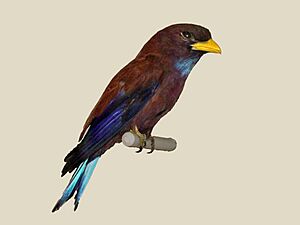Blue-throated roller facts for kids
Quick facts for kids Blue-throated roller |
|
|---|---|
 |
|
| Conservation status | |
| Scientific classification | |
 |
|
| resident range |
The blue-throated roller (Eurystomus gularis) is a colorful bird found in the rainforests of Africa. It belongs to a bird family called rollers. These birds are known for their bright feathers and interesting flying habits.
Contents
About the Blue-throated Roller
The blue-throated roller was first officially described in 1819. A French bird expert named Louis Pierre Vieillot gave it its scientific name, Eurystomus gularis. The word gularis comes from Latin and means "throated." This name refers to the bird's blue throat.
Scientists have studied the blue-throated roller's family tree. They found that it is most closely related to another bird called the broad-billed roller.
Different Kinds of Blue-throated Rollers
There are two main types, or subspecies, of the blue-throated roller:
- E. g. gularis: This type is found from Guinea to western Cameroon.
- E. g. neglectus: This type lives from southeastern Nigeria and southern Cameroon all the way to northern Angola and Uganda.
What Does It Look Like?
The blue-throated roller is a sturdy bird with a large head and a thick neck. It often sits high up in trees. Most of its body is a dark chestnut brown. It has a bright yellow beak. Its throat has a clear blue patch. The tail is also blue, and its wings are a purplish-blue color.
Young blue-throated rollers have more blue on their undersides. When flying, this bird looks a bit like a falcon because of its long wings. It measures about 25 centimeters (about 10 inches) long. Males usually weigh between 82 and 117.5 grams, while females weigh 88 to 108 grams.
Where Does It Live?
The blue-throated roller lives in western sub-Saharan Africa. You can find it from Guinea to Cameroon, south to northern Angola, and west to southeastern Uganda. It also lives on Bioko Island.
These birds like to stay high up in the treetops. They hunt for food above the forest canopy. They prefer areas like clearings, riverbanks, and very tall trees. They can also be found in plantations and patches of forest in cleared areas.
How Does It Behave?
Blue-throated rollers often perch alone or in pairs on bare branches. They like to sit at the very top of the trees. They can stay still for a long time. Sometimes, they make loud, chattering calls.
When they are active, they fly out to catch insects in the air. They also bravely defend their territory from other birds. In the late afternoon, they gather in small groups. These groups often include broad-billed rollers. They feed on ants and termites that come out after it rains. The rollers catch these insects while flying, performing amazing acrobatics. They can eat many insects this way. One roller might eat over 700 insects, weighing about 40 grams, in one feeding session!
Nesting and Babies
When it's time to have babies, the blue-throated roller becomes very protective of its territory. Courtship and defending their space involve noisy chases in the air.
They build their nests in tree cavities (holes in trees). These nests are usually about 10 meters (about 33 feet) up the tree trunk. They often choose trees at the edge of a clearing. Females lay 2 to 3 eggs. The time they lay eggs varies by location. For example, it's February to March in Ivory Coast and April and September in Nigeria.



